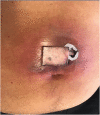Disseminated Saksenaea infection in an immunocompromised host associated with a good clinical outcome: a case report and review of the literature
- PMID: 33054720
- PMCID: PMC7559758
- DOI: 10.1186/s12879-020-05459-9
Disseminated Saksenaea infection in an immunocompromised host associated with a good clinical outcome: a case report and review of the literature
Abstract
Background: Saksenaea species (spp.) are uncommon causes of mucormycosis but are emerging pathogens mostly associated with trauma and soil contamination often in immunocompetent hosts. Due to lack of sporulation in the laboratory, diagnosis and susceptibility testing is difficult so optimal treatment regimens are unknown.
Case presentation: A 67 year-old man from the Northern Territory in Australia, with a history of eosinophilic granulomatosis with polyangiitis, developed disseminated Saksenaea infection after initially presenting with symptoms consistent with bacterial pyelonephritis. Despite a delay in diagnosis; with aggressive surgical management and dual therapy with amphotericin B and posaconazole, he survived.
Conclusions: We describe an unusual case of disseminated infection with a favourable outcome to date.
Keywords: Amphotericin B; Disseminated fungal infection; Mucormycosis; Posaconazole.
Conflict of interest statement
The authors declare that they have no competing interests.
Figures



References
-
- Saksena SB. A new genus of the Mucorales. Mycologia. 1953;45(3):426–436. doi: 10.1080/00275514.1953.12024280. - DOI
Publication types
MeSH terms
Substances
Supplementary concepts
LinkOut - more resources
Full Text Sources
Miscellaneous

